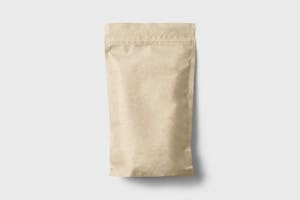June 12, 2025

With industries across the board actively prioritizing sustainability, bioplastic pouches have emerged as a transformative innovation in plastic packaging, offering a renewable alternative to traditional plastics while meeting the growing demand for environmentally responsible solutions.
Unveiled by Accredo Packaging at PackExpo 2024, these pouches are composed of 100% sugarcane-derived polyethylene, making it a fully bio-based and recyclable packaging solution to utilize. Designed for recyclability, they align with consumer expectations for more sustainable packaging options, providing brands with a practical yet forward-thinking solution that integrates seamlessly into existing supply chains.
With recent advancements in material science and manufacturing, bioplastic pouches are redefining what’s possible in sustainable plastic packaging, positioning themselves as a viable alternative for industries seeking both functionality and environmental responsibility.
Shifting away from fossil-based plastics, sugarcane-derived polyethylene offers a renewable alternative that supports long-term environmental sustainability without compromising performance.
The innovative bioplastic, sourced from sugarcane rather than petroleum, actively contributes to carbon reduction by capturing and storing 2,150 kg of CO₂ per ton, which is the equivalent of removing approximately 43 grams of carbon dioxide per pouch from the atmosphere.
Unlike some plant-based materials that raise concerns over food resource competition, this sugarcane resin is cultivated without impacting global food supplies, addressing a major challenge in sustainable material sourcing.
The result is a packaging solution that significantly lowers greenhouse gas emissions while maintaining the properties manufacturers and consumers expect from traditional polyethylene.
A single-material composition simplifies the recycling process, making these pouches fully compatible with store drop-off programs available across the country. Consumer expectations for sustainable plastic packaging continue to grow, with a strong preference for solutions that provide both environmental benefits and everyday convenience.
While some biodegradable or compostable alternatives struggle to match the strength and longevity required for many packaging applications, this sugarcane-based polyethylene retains the durability, flexibility, and shelf life of conventional plastics.
Having a balance of functionality and sustainability makes the material well-suited for broad adoption across industries looking to reduce their environmental footprint without disrupting supply chain efficiency or packaging performance.

Sustainable packaging extends beyond material selection, requiring advanced manufacturing processes that minimize environmental impact without sacrificing performance.
The manufacturer’s 100% wind-powered operations help significantly contribute to carbon reduction efforts by eliminating reliance on fossil-fuel-generated electricity, aligning with broader sustainability goals.
Through machine-direction orientation (MDO), the company enhances the film’s heat resistance, optical properties, and mechanical strength, giving it characteristics similar to PET while maintaining the recyclability of polyethylene.
Achieving these properties requires precise control over temperature, pressure, and cooling during production, making sure that each pouch meets stringent quality standards while preventing excess material waste.
Reducing resource consumption in plastic packaging production goes beyond raw materials, extending to the printing process itself. Expanded gamut printing significantly cuts down on ink waste, reducing it by up to 90% compared to traditional methods.
The technique eliminates the need for pre-mixed inks, allowing for seamless transitions between print jobs while maintaining color consistency. So, instead of discarding unused ink between runs, the process optimizes ink application by utilizing a standardized set of base colors, dramatically reducing both waste and energy consumption.
While sustainability is a priority, maintaining high-quality visuals remains essential for brands, and this printing innovation supports both objectives by delivering vibrant, high-resolution graphics while minimizing environmental impact.
Bioplastic pouches are gaining significant traction across multiple industries, with food, personal care, petcare, and household products emerging as primary adopters.
Companies in these sectors recognize the need for packaging that supports sustainability goals while maintaining the functionality, performance, and aesthetics required for consumer appeal. Premium brands, in particular, are seeking alternatives that reduce environmental impact without sacrificing product integrity, shelf stability, or ease of use.
With consumer awareness of sustainable packaging growing even further, businesses that incorporate bio-based solutions position themselves as leaders in corporate responsibility while meeting the demand for greener products.

Sustainability is no longer a niche concern but a core expectation among both consumers and businesses, leading many brands to prioritize plastic packaging that reduces waste, enhances recyclability, and maintains high-performance standards.
The positive reception at Pack Expo demonstrated strong industry interest, with several large brands actively exploring the transition to fully bio-based pouches. Companies already incorporating 25-75% bio-based content in their packaging are looking to expand their use of sustainable materials, reflecting a broader shift toward environmentally conscious design.
Bioplastic innovations are redefining the packaging industry, offering renewable, high-performance alternatives that address environmental concerns without compromising functionality.
With more companies embracing sustainability, advancements like sugarcane-derived polyethylene pouches demonstrate how plastic packaging can evolve to meet both business and consumer expectations. The demand for eco-friendly solutions continues to grow, and brands that prioritize sustainable materials position themselves at the forefront of this transformation.
To stay informed on the latest breakthroughs in sustainable plastics innovations, consider joining PLASTICS, the Plastics Industry Association. Membership provides updates on cutting-edge developments, access to recycling inititiatives, and the opportunity to drive positive change in the industry.
PLASTICS and the Future Leaders in Plastics (FLiP) Committee are devoted to supporting and encouraging the next generation of plastics leaders who will play a crucial role in the innovation, technology and future of the plastics industry. FLiP’s mission is to provide young professionals under the age of 40 the exposure, education and resources they need to build lifelong careers in plastics. Want to join? Want to get your employees involved? Email: [email protected]